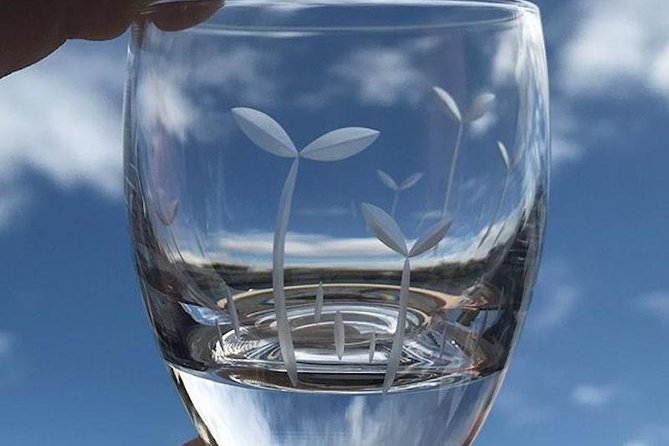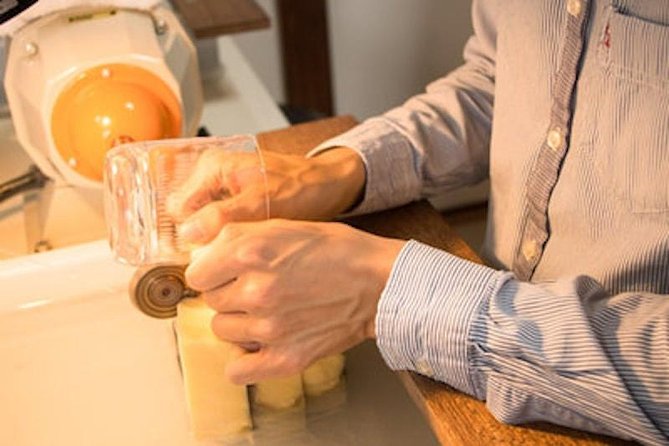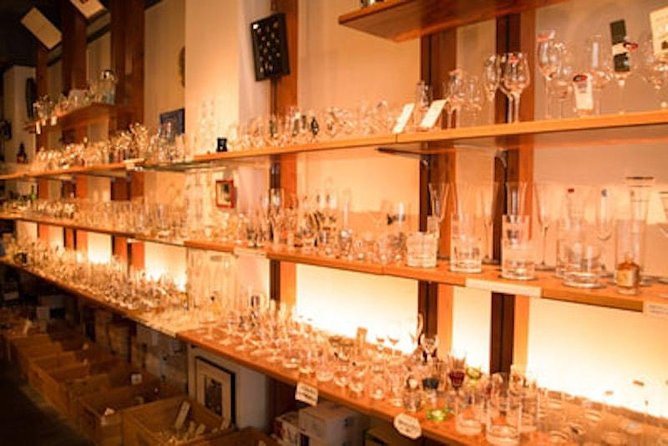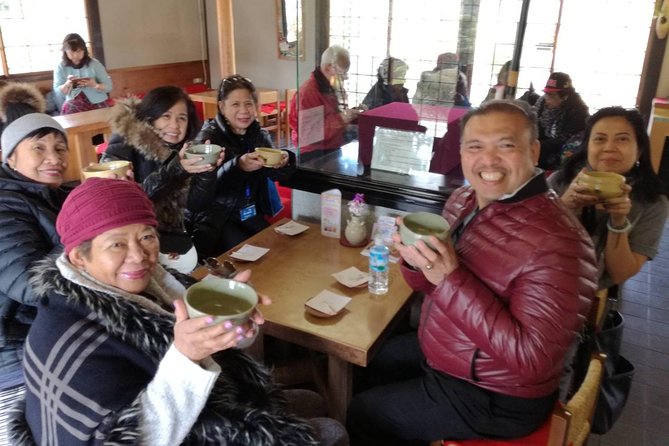Set out on a unique artistic journey with the Traditional Glass Carving Experience in Tokyo.
This immersive workshop, held at Glass Factory Sokichi, offers participants the opportunity to learn the ancient art of glass carving.
Under the guidance of a skilled instructor, attendees will delve into the delicate etching of intricate designs and the meticulous shaping of glass objects.
With practical information and a maximum capacity of 15 travelers, this experience provides a glimpse into Tokyo’s rich artistic heritage.
Quick Takeaways

- Glass carving in Tokyo has a long history dating back to the Edo period and is influenced by traditional Japanese art forms.
- The unique style and techniques of glass carving in Tokyo reflect precision and attention to detail valued in Japanese culture.
- The tools used in glass carving include diamond burrs, grinding wheels, lapping plates, glass cutters, brushes, and tweezers.
- The step-by-step process of glass carving involves sketching the design, etching and carving with specialized tools, polishing the glass, and contributing to the preservation of Tokyo’s cultural heritage.
History of Glass Carving in Tokyo
The history of glass carving in Tokyo dates back to the Edo period, when skilled artisans began honing their craft in the capital city of Japan. Influenced by traditional Japanese art forms such as pottery, lacquerware, and woodblock prints, glass carving in Tokyo developed its own unique style and techniques.
The intricate designs and delicate details of glass carvings reflect the precision and attention to detail that are highly valued in Japanese culture. Glass carving has become culturally significant in Tokyo, not only as a decorative art form but also as a symbol of craftsmanship and tradition.
Today, visitors to Tokyo can witness the beauty of glass carving and appreciate its connection to traditional Japanese art at various glass studios and museums throughout the city.
Tools and Techniques Used in Glass Carving

Glass carving requires a combination of specialized tools and techniques, and artisans use them to create intricate designs on glass surfaces. In glass carving workshops, participants have the opportunity to learn and practice traditional glass carving techniques under the guidance of skilled instructors. These workshops typically provide all the necessary tools and materials for participants to use during the session.
Here is a table showcasing some of the tools commonly used in glass carving:
| Tools | Description |
|---|---|
| Diamond Burrs | Used for shaping and detailing the design |
| Grinding Wheels | Used for smoothing and polishing the glass |
| Lapping Plates | Used for flattening and refining the surface |
| Glass Cutters | Used for scoring and cutting the glass |
| Brushes and Tweezers | Used for cleaning and handling the glass |
Step-by-Step Process of Glass Carving

Fortunately, participants in the traditional glass carving experience in Tokyo can learn the step-by-step process of glass carving under the guidance of skilled instructors. The history of glass carving techniques dates back centuries, with Tokyo being a hub for this art form. Glass carving holds cultural significance in Tokyo, as it’s a traditional craft that has been passed down through generations.
The process begins with selecting a glass piece and sketching the design. Then, using specialized tools such as diamond burrs and drills, the carver carefully etches and carves the design onto the glass surface. This requires precision and patience. Once the carving is complete, the glass piece is polished to enhance its clarity and shine.
Participants in this experience not only gain a deeper understanding of the intricate process of glass carving but also contribute to the preservation of Tokyo’s cultural heritage.
Tips for Creating Beautiful Glass Carvings
With some practice and attention to detail, participants can create beautiful glass carvings during the traditional glass carving experience in Tokyo. Here are some tips for beginners to help them create stunning pieces of art while avoiding common mistakes:
- Start with simple designs: It’s best to begin with simple designs and gradually progress to more complex ones as you gain experience and confidence.
- Use the right tools: Ensure that you have the appropriate tools for glass carving, such as diamond burrs and engraving bits, to achieve clean and precise cuts.
- Take your time: Glass carving requires patience and precision. Take your time to carefully plan and execute each cut, ensuring that you maintain a steady hand throughout the process.
- Practice on scrap glass: Before working on your final piece, practice on scrap glass to familiarize yourself with the techniques and gain confidence in your carving abilities.
- Avoid excessive pressure: Applying too much pressure while carving can lead to chipping or breaking the glass. Use gentle and controlled movements to achieve the desired results.
Famous Glass Carving Artists in Tokyo

There are many renowned glass carving artists in Tokyo who’ve mastered the art of creating intricate designs on glass. These artists have gained recognition for their exceptional skills and have showcased their work in famous glass carving exhibitions across the city.
Their creations often feature delicate and detailed patterns, showcasing their expertise in this traditional craft.
Along With their exhibitions, some of these artists also offer glass carving workshops for beginners, providing an opportunity for enthusiasts to learn the techniques and intricacies of this art form. These workshops allow participants to not only appreciate the beauty of glass carving but also to try their hand at creating their own unique designs under the guidance of these talented artists.
Where to Find and Purchase Glass Carvings in Tokyo
Visitors to Tokyo can frequently find and purchase glass carvings at various specialty shops and art galleries throughout the city. Here are some places to check out:
- Tokyo Hands – This popular department store offers a wide selection of glass carvings, including traditional designs and modern interpretations.
- Asakusa Culture Tourist Information Center – Located in the historic Asakusa district, this center has a gift shop that sells glass carvings made by local artisans.
- Hakone Yosegi Zaiku – While not in Tokyo, this shop in the nearby Hakone region is worth a visit for its intricate glass carvings and traditional techniques.
- Tokyo City View Gift Shop – Situated in the Mori Tower, this gift shop offers glass carvings inspired by Tokyo’s iconic skyline and landmarks.
- Ebisu Antique Market – Held twice a month, this market is a treasure trove of vintage glass carvings, perfect for collectors and enthusiasts.
Whether you’re On the lookout for the best glass carving classes in Tokyo or traditional glass carving designs to take home as souvenirs, these shops and galleries have you covered.
Here's some more great Japan experiences nearby that we think you'll like.
Frequently Asked Questions
Are There Any Age Restrictions for the Traditional Glass Carving Experience in Tokyo?
There are no age restrictions for the traditional glass carving experience in Tokyo. However, participants are advised to follow safety precautions and ensure that children are supervised by an adult.
Is It Necessary to Have Prior Experience in Glass Carving to Participate in the Activity?
No prior experience is necessary to participate in the activity. The importance of creativity and the benefits of learning a new skill are emphasized. Participants of all skill levels can enjoy the traditional glass carving experience in Tokyo.
How Long Does the Traditional Glass Carving Experience in Tokyo Typically Last?
The traditional glass carving experience in Tokyo typically lasts around two hours. Participants can create a variety of designs, such as flowers, animals, and geometric patterns. To book, visit Attractive JAPAN’s website.
Is It Possible to Customize the Design or Pattern for the Glass Carving During the Experience?
Yes, participants in the Traditional Glass Carving Experience in Tokyo have the option to customize the design or pattern of their glass carving. They can choose from a range of design choices provided by the instructor.
Can Participants Take Their Finished Glass Carvings Home With Them After the Experience?
Participants can take their finished glass carvings home with them after the experience, making it a perfect opportunity to create a unique and personalized souvenir.
The Sum Up
To sum it up, the Traditional Glass Carving Experience in Tokyo offers a unique opportunity for participants to learn the ancient art of glass carving.
Under the guidance of a skilled instructor, attendees can explore the delicate techniques and intricate designs involved in this craft.
With practical information provided, such as access to the meeting point and traveler tips, this immersive experience promises to be educational and enjoyable.
Don’t miss the chance to create your own glass masterpiece and delve into Tokyo’s rich artistic heritage.
Where To Stay In Tokyo
Tokyo visitor levels are currently at an all-time high so make sure to book your hotels early. Tip most hotels booked with booking.com have free cancelation so book as soon as you know your date and you can always cancel if you change your mind.





